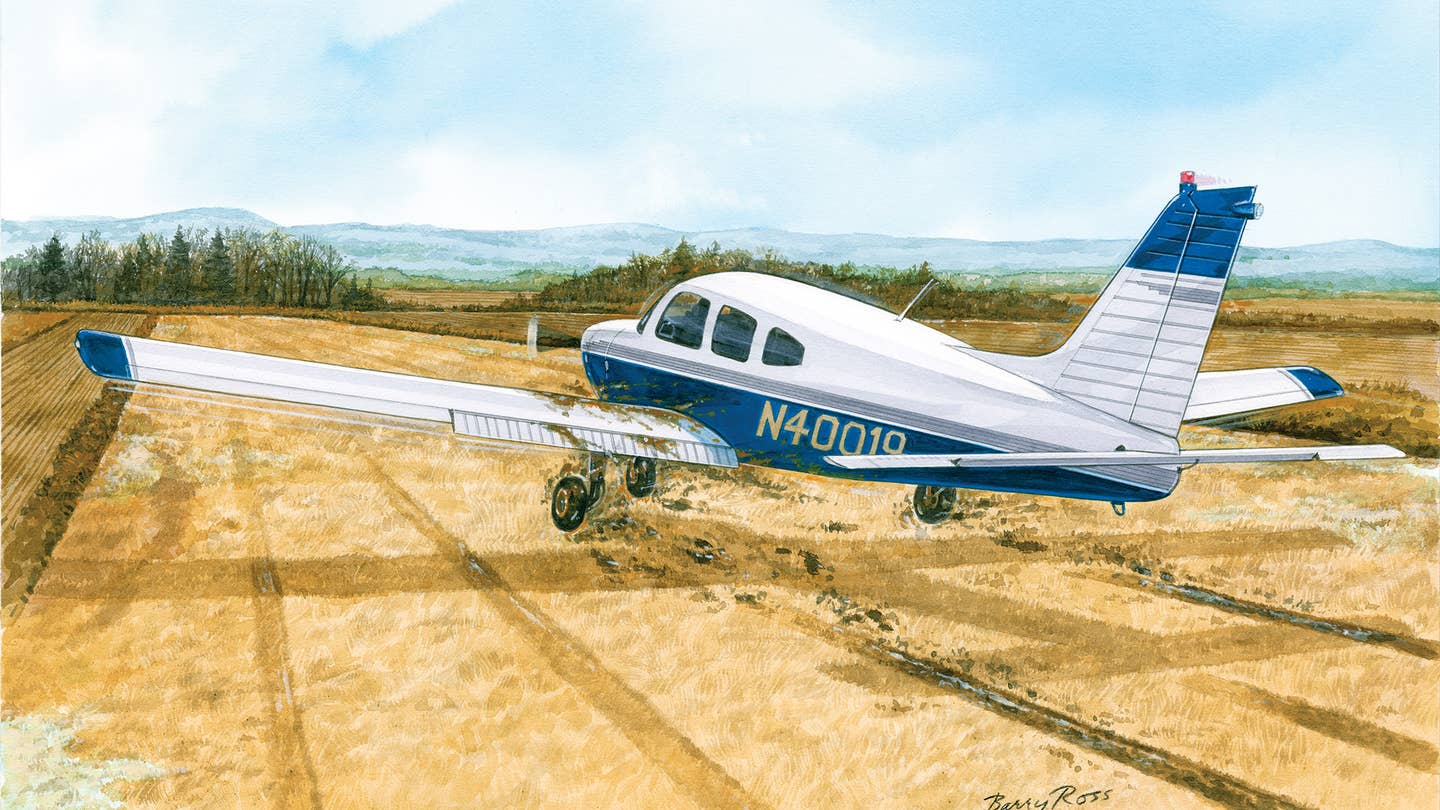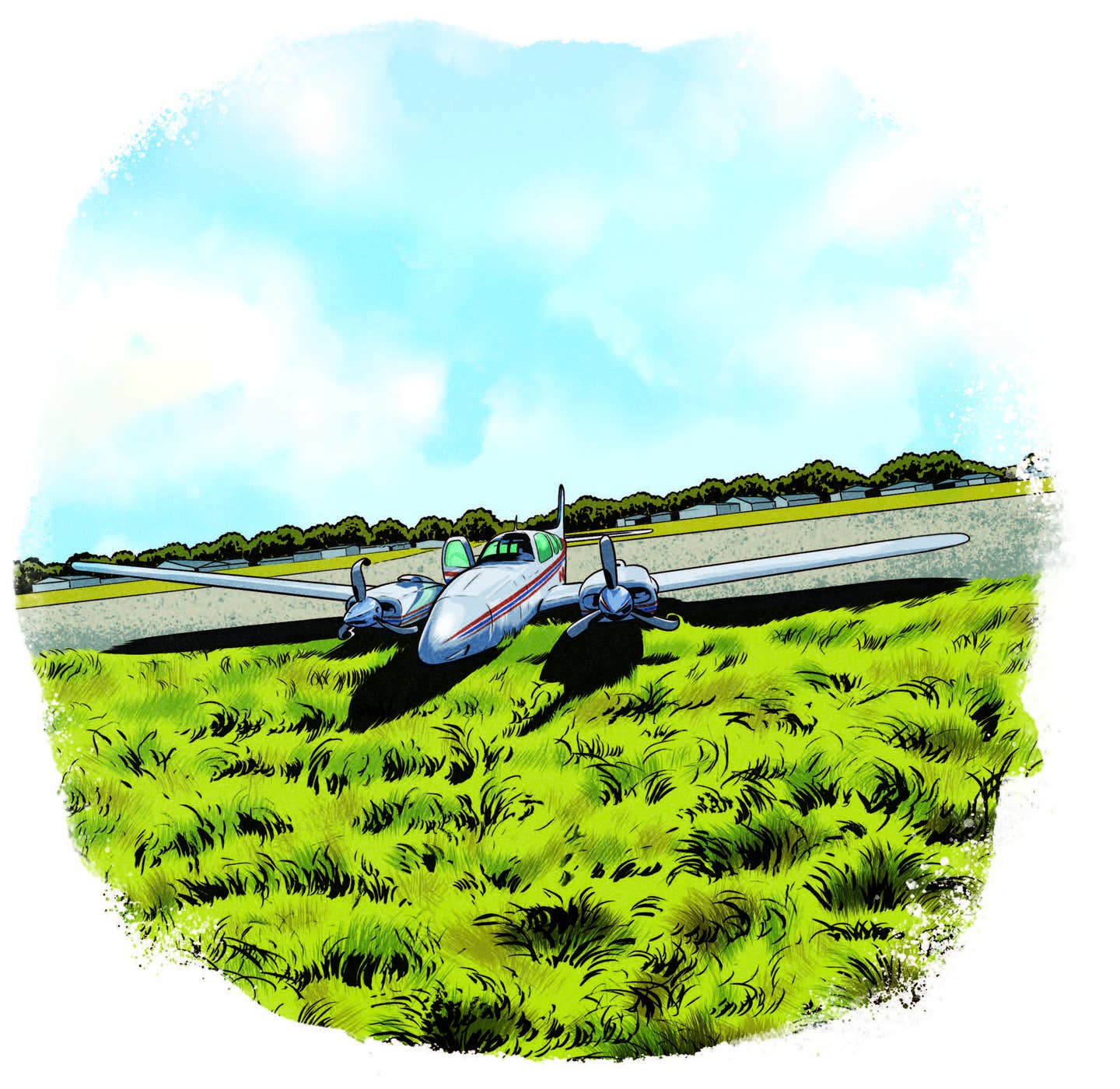
In this month’s I Learned about Flying from That, a pilot learns valuable lessons from a grass strip in early spring. Barry Ross/BarryRossArt.com
It was a chilly March day in New Jersey, but the temperatures were finally rising above freezing on a regular basis. Signs of snow had all but vanished, and we CFIs at the flight school were looking forward to the start of spring and better flying weather.
On my schedule was a private pilot with whom I would occasionally meet for a refresher flight. As always, he reserved our Piper PA-28 Warrior for a two-hour block of dual instruction. Though legally current, my client didn’t fly often and was a relatively low-time pilot. Before heading out, we established a plan, which included performing stalls, steep turns and emergency procedures because he thought those were the areas where he had the least recent experience.
I suggested some takeoff and landing practice, including soft- and short-field work.
We flew to our usual practice area and covered the airwork before I pulled the throttle well above the nice little airfield with its short runway at Aeroflex-Andover (12N). He did a good job with his engine-out and short-field procedures. As we departed back toward Essex County Airport (KCDW), I asked if he had done any actual soft-field landings. He replied that he hadn’t, but had always wanted to try.
I directed him toward nearby Trinca Airport (13N), a 1,920-foot grass strip that I visited many times over the years. I had him fly over the field, and we took a good look at the runway, which appeared clean and solid. I observed no signs of water or mud, and the turf appeared to be in good shape. Though I understood the risks of soft fields after the winter,
I had more than a thousand hours in PA-28s and felt very comfortable with soft-field takeoffs and landings. Up to now, that is.
The wind was from the west, so we flew the pattern for Runway 24. The approach went as planned. We flared with a little power and gently placed the mains onto what now appeared to be a surface that was softer and wetter than I’d thought. During the rollout, I realized the turf was in bad shape in some areas and I became concerned about the possibility of getting stuck.
I realized that we needed to get out of there or risk needing to make a call back to my boss explaining that his airplane was stuck in the mud.
I took back the controls and explained that I would be turning the airplane around for back-taxi and to prepare for takeoff. I explained that I would demonstrate the takeoff technique, so I set the flaps at 25 degrees and taxied around patches of mud as I headed to the runway threshold. I made a 180-degree turn and pointed the airplane at what appeared to be the firmest and driest part on the strip.
I applied full power and added back-pressure on the yoke, resulting in bumpy acceleration as the gear splattered mud all over the front of the airplane. As expected, acceleration was slow, and though the airplane was attempting to lift into ground effect, the patches of mud were causing much resistance, holding the airspeed below what was needed to get us off the ground. As I tried to nudge the aircraft into ground effect we would lift slightly, with the stall indicator sounding, yet any contact with the surface would immediately reduce airspeed and lift. We were in a region where the airplane was simply not gaining enough speed for constant level flight in ground effect, occasionally touching the muddy turf surface, which in turn retarded the airspeed.
We were in a window where the airspeed would allow a little lift yet not enough to stay out of the mud. Too high angle-of-attack or a little too much altitude and the plane would lose lift and splash down into the mud. Knowing that this could turn into a dangerous porpoise down the field, I continued to search for the small AOA window (which must be reduced as airspeed climbs), which would permit enough acceleration in ground effect to allow for a safe liftoff.
After passing the halfway mark, I realized we were beyond the safe abort point. We would clearly not be able to stop before hitting the tree line ahead. I had no choice but to continue and gain the necessary airspeed.
As the airspeed indicator bobbed up and down between 40 and 50 knots, my left-seat customer started insisting we abort, but I knew that would have resulted in a guaranteed disaster and I felt I was starting to maintain control in ground effect and the ASI was trending upward. The stall indicator was still sounding, but I now had the airplane solidly off the turf and the ASI was rising over 50 knots. My client now abruptly implored “Climb!” As we watched the tree line straight ahead getting larger, I replied with a solid “Not yet!” I am sure it looked very concerning, and maybe downright terrifying for my client, but I knew that we had to maintain the aircraft in level flight just above the ground (with the trees in the windshield) until we accelerated to just below Vx.
At about 60 knots, with a silent stall indicator (finally!), I gently rotated to best angle pitch and we climbed over the trees at Vx, clearing the tree line by around 300 feet, much too close for this nonbush pilot. With sweaty palms, I turned the yoke to head toward home. I explained all was OK, and we would discuss the details of our harrowing departure once we got back to the flight school.
Back on the ground, I parked the airplane next to a water hose to allow me to later clean off the mud-covered airplane. It was a mess!
I debriefed with my client and reviewed a few of the things we learned on the flight. I explained (and confirmed) that soft-field performance is far from an exact science, and in many cases the actual runway requirement for takeoff and landing is not only unknown but sometimes impossible to judge.
I explained that I was wrong to attempt landing at this or any turf field without a recent firsthand report on the runway conditions, which in this case would have completely altered our decision. I also emphasized two important points: First was the challenge and skill needed to get the aircraft into, and remain in, the small window just above the ground where the gear is above the turf but not too high where it will sink back down. One must get the airplane into ground effect as soon as possible, but the slightest settle back onto the mains will forfeit a significant amount of airspeed, resulting in the need for hundreds of feet of additional runway to recover the lost speed. This is much more challenging than anticipated when the only experience a pilot has is from simulations on hard surfaces where touching the ground results in minimal loss of airspeed.
The workload, accuracy and finesse required to maintain and accelerate in ground effect is far beyond what is demonstrated and practiced on a hard surface. The skill needed is analogous with and possibly more challenging than learning the landing round-out and flare.
Second was to allow proper acceleration in ground effect and not climb out of ground effect until reaching Vx, or risk one of those departure stalls we all have practiced up at altitude. A departure stall at low altitude will almost certainly result in a bad ending, and in our case, impact with trees.
This was one of those times in a pilot’s life where what looks innocent ends up being very much the contrary. These situations can result in invaluable experience gained, but without proper knowledge going into it, they often end in accidents.
Pilots who regularly fly in and out of turf fields usually have ongoing recent knowledge about field conditions and have a much better ability to interpret runway conditions during a visual low pass. What I’ve learned, for those of us with limited soft-field experience, is that it’s wise to get a firsthand field report before landing. Most public fields have a published phone number readily available.
I now realize that, because this field was less than 2,000 feet long, after landing and seeing the runway condition was soft and muddy, I should not have attempted the takeoff. I would have been better off hearing my less-than-thrilled boss’s voice when I explained that we wouldn’t be able to safely depart rather than my family getting the phone call had the departure ended badly. A bruised ego is so much better than a bruised body.
Robert M. Hanrahan has over 3,000 hours of flight time and holds an ATP and CFII/MEI certificates. On the weekends Bob can be found teaching at Century Air/KCDW.

Sign-up for newsletters & special offers!
Get the latest FLYING stories & special offers delivered directly to your inbox






